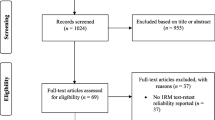Abstract
A 6- item physical performance test assessing hand strength/speed, mobility, and balance was administered to 678 elderly people from a Japanese community (age 65–89). A second- order covariance structure model applied to the data revealed that three factors in observed variables (Hand Power, Walking, and Balance) had loadings more than 0.8 on a single higher- order factor, Basic Motor Ability (BMA). The BMA score, or “Physical Performance Age (PPA)”, of the individual was calculated on the basis of this model as a unidimensional summary score of physical performances. The PPA predicted the self- reported levels of competence and physical activity with greater accuracy than age alone. The PPA also differentiated those at the high end of the functional spectrum, and thereby not identifiable by use of ordinary self- reported functional measures. The results suggest that a short physical performance battery assessing physical functioning is useful in community- based studies of aging.
Similar content being viewed by others

References
Briggs R.C., Gossman M.R., Drews J.E., Shaddeau S.A.: Balance performance among noninstitutionalized elderly women. Phys. Therapy 70: 410–415, 1989.
Tinetti M.E., Ginter S.F.: Identifying mobility dysfunctions in elderly patients. Standard neuromuscular examination or direct assessment? JAMA 259: 1190–1193, 1988.
Carter J.S., Williams H.G., Macera C.A.: Relationships between physical activity habits and functional neuromuscular capacities in healthy older adults. J. Appl. Gerontol. 12: 283–293, 1993.
Greene L.S., Williams H.G., Macera C.A.: Identifying dimensions of physical (motor) functional capacity in healthy older adults. J. Aging Health 5: 163–178, 1993.
Era P.: Sensory, psychomotor and motor functions in men of different ages. Scand. J. Soc. Med. 39: 9–77, 1990.
Blair S.N.: Physical activity, physical fitness, and health. Res. Quart. Exer. Sport 64: 365–376, 1993.
Guralnik J.M., Branch L.G., Cummings S.R., Curb J.D.: Physical performance measures in aging research. J. Gerontol. 44: M141–M146, 1989.
Guralnik J.M., Simonsick E.M., Ferrucci L., Glynn R.J., Berkman L.F., Blazer D.G., Scherr P.A., Wallace R.B.: A short physical performance battery assessing lower extremity function: Association with self-reported disability and prediction of mortality and nursing home admission. J. Gerontol. 49: M85–M94, 1994.
Koyano W., Shibata H., Nakazato K., Haga H., Suyama Y.: Measurement of competence: reliability and validity of the TMIG Index of Competence. Arch. Gerontol. Geriatr. 13: 103–116, 1991.
Nagasaki H., Itoh H., Furuna T.: A physical fitness model of older adults. Aging Clin. Exp. Res. 7: 392–397, 1995.
Furuna T., Nagasaki H., Itoh H., Hashizume K., Kinugasa T., Maruyama H.: Motor abilities of older adults in Japanese urban and rural communities (in Japanese). Jpn. J. Phys. Fitness Sports Med. 44: 347–356, 1995.
Shibata H., Suzuki T., Shimonaka Y., Koyano W.: Launch of a new longitudinal interdisciplinary study on aging by Tokyo Metropolitan Institute of Gerontology (TMIG-LISA). Fact Res. Gerontol. 1: 277–294, 1993.
Nagasaki H., Itoh H., Maruyama H., Hashizume K.: Characteristic difficulty in rhythmic movement with aging and its relation to Parkinson’s disease. Exp. Aging Res. 14: 171–176, 1988.
Lawton M.P.: Assessing the competence of older people: In: Kent D.P., Kastenbaum R., Sherwood S. (Eds.), Research Planning and Action for the Elderly: the Power and Potential of Social Science. Human Sciences Press, New York, 1972, pp. 122–143.
Fleishman E.A.: The structure and measurement of physical fitness. Prentice-Hall, Englewood Cliffs, NJ, 1964.
Nakamura E., Moritani T., Kanetaka A.: Biological age versus physical fitness age. Eur. J. Appl. Physiol. 58: 778–785, 1989.
Guralnik J.M., Seeman T.E., Tinetti M.E., Nevitt U.C., Berkman L.F.: Validation and use of performance measures of functioning in a non-disabled older population: MacArthur studies of successful aging. Aging Clin. Exp. Res. 6: 410–419, 1994.
Long J.S.: Confirmatory factor analysis: A preface to LIS-REL. Sage Publications, Beverly Hills, 1983.
Falls H.B.: Modern concept of physical fitness. JOPER 51: 25–27, 1980.
Canadian standardized test of fitness. Fitness Canada, Ottawa, 1987.
Author information
Authors and Affiliations
Rights and permissions
About this article
Cite this article
Nagasaki, H., Itoh, H. & Furuna, T. The structure underlying physical performance measures for older adults in the community. Aging Clin Exp Res 7, 451–458 (1995). https://doi.org/10.1007/BF03324360
Received:
Accepted:
Published:
Issue Date:
DOI: https://doi.org/10.1007/BF03324360



